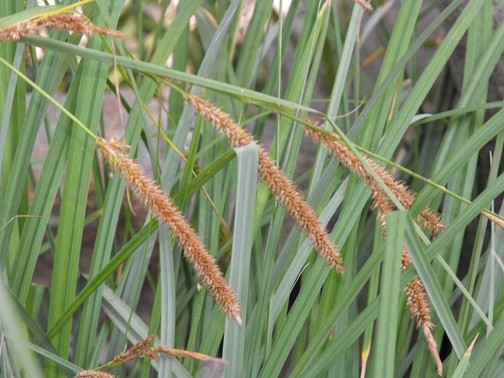San Diego Sedge
(Carex spissa)
San Diego Sedge (Carex spissa)
/
/

Stickpen
Public domain
Image By:
Stickpen
Recorded By:
Copyright:
Public domain
Copyright Notice:
Photo by: Stickpen | License Type: Public domain | License URL: https://creativecommons.org/public-domain/ | Uploader: Stickpen | Publisher: Wikimedia Commons | Title: Carexspissa2.JPG | Notes: User created page with UploadWizard |















Estimated Native Range
Summary
Carex spissa, commonly known as San Diego sedge, is a perennial herbaceous plant native to riparian zones, wetlands, and occasionally serpentine soils in Southern California and Baja California, Mexico. It thrives in moist environments such as seeps, streambanks, and marshy areas. This robust sedge can reach over a meter in height and is characterized by its leathery green to reddish leaves that can grow up to 1.2 meters long. The inflorescence of Carex spissa is particularly striking, extending up to 80 centimeters with numerous reddish-brown flower spikes. Each spike can hold up to 300 developing fruits, which are of interest to botanists and gardeners alike. The plant’s resemblance to cattail is notable, though it is a distinctly different species.
San Diego sedge is valued for its adaptability to wet conditions and is often used in water gardens, rain gardens, and for erosion control along waterways. It provides habitat and food for wildlife, particularly birds. In cultivation, it requires full sun to partial shade, consistent moisture, and prefers soils with medium drainage. While it is not known for being particularly problematic, gardeners should be aware that, like many sedges, it can spread if conditions are favorable, potentially outcompeting other plants in small garden settings.CC BY-SA 4.0
San Diego sedge is valued for its adaptability to wet conditions and is often used in water gardens, rain gardens, and for erosion control along waterways. It provides habitat and food for wildlife, particularly birds. In cultivation, it requires full sun to partial shade, consistent moisture, and prefers soils with medium drainage. While it is not known for being particularly problematic, gardeners should be aware that, like many sedges, it can spread if conditions are favorable, potentially outcompeting other plants in small garden settings.CC BY-SA 4.0
Plant Description
- Plant Type: Grass
- Height: 2-4 feet
- Width: 2-4 feet
- Growth Rate: Rapid
- Flower Color: N/A
- Flowering Season: Spring
- Leaf Retention: Evergreen
Growth Requirements
- Sun: Full Sun
- Water: Medium
- Drainage: Medium
Common Uses
Bird Garden, Border Plant, Deer Resistant, Groundcover, Low Maintenance, Potted Plant, Water Garden
Natural Habitat
Native to riparian zones, wetlands, and occasionally serpentine soils in Southern California and Baja California, Mexico
Other Names
Common Names:
Scientific Names: Carex spissa
GBIF Accepted Name: Carex spissa L.H.Bailey ex Hemsl.